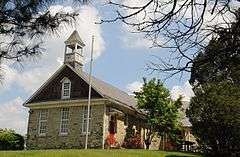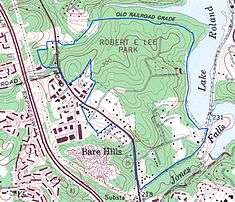Bare Hills Historic District
|
Bare Hills Historic District | |
|
Bare Hills School | |
|
Bare Hills Historic District Boundary | |
| Location | Falls Rd. between Light Rail and north of Coppermine Terrace, Towson, Maryland |
|---|---|
| Coordinates | 39°23′14″N 76°39′34″W / 39.38722°N 76.65944°WCoordinates: 39°23′14″N 76°39′34″W / 39.38722°N 76.65944°W |
| Area | 275 acres (111 ha) |
| Architectural style | Gothic Revival; Mid-Century Modern |
| NRHP Reference # | 11000852[1] |
| Added to NRHP | November 22, 2011 |
The Bare Hills Historic District encompasses a residential area north of Baltimore, Maryland in Baltimore County, which had industrial beginnings before being transformed into a suburb of the city. The district includes Robert E. Lee Park, as well as a cluster of largely vernacular dwellings between the park and Falls Turnpike that was built mainly in the 19th century.
Situated on a serpentine barrens, its thin and unfertile serpentine soil defined the Bare Hills area. Dr. H. H. Hayden documented the discovery of the area's mineral value:
- Until the year 1808 or 1810, little was known of the mineralogical character of these hills, and little else was obvious to the traveler besides their repulsive aspect. About this time, the chromate of iron, in small irregular or rolled masses, was discovered in one of the deep ravines, by Mr. Henfrey, a gentleman who it is believed, was the discoverer of chrome, titanium, and several other interesting minerals, in this part of the country. Subsequently, and particularly since the commencement of regular operations for obtaining chromate of iron, this district has excited, especially among mineralogists, a degree of interest not surpassed, perhaps, in the case of any locality in the United States.[2]
The discovery occurred on Jesse Tyson's farm. Tyson's son Isaac Tyson, Jr. successfully mined the Bare Hills for chromite and identified other serpentine barrens in Maryland as chromite sources, including the Soldiers Delight area in western Baltimore County. His acumen established Maryland as the world's leading producer of chrome until the the middle of the 19th century. All extraction at Bare Hills ceased by 1833.[3]
Bare Hills is also notable as the site of one of the earliest free African-American communities in Baltimore County, established about 1830 by Aquila Scott. Per the registration document for Bare Hills in the National Register of Historic Places:
- Aquila (Aquilla) Scott, a blacksmith by trade as well as a Methodist preacher, arrived in the Bare Hills area by 1830. Descended from a St. Mary's County freed-slave named Tobias Scott, Aquila Scott was among a growing population of free blacks in Maryland. In 1833, Scott was named among the five trustees of a small congregation of the Bethel Episcopal Methodist Religious Society in a deed from Mary and Elijah Fishpaw. The deed was for land in the northeast corner of the Hopyard tract on which to build a church, later called St. John's Church. Though the church was located on the east side of the Jones Falls and the B&S (Baltimore and Susquehanna) Rail Road, Aquila Scott purchased two acres of land in 1839 from Johnzee Hook on the summit of the Bare Hills. The parcel fronted onto the Falls Turnpike and there Scott established his blacksmith shop and dwelling house. As Scott's family often children grew and eventually started their own families, they built their houses on the two-acre tract and the community became known as "Scott's Settlement." Aquila Scott died in 1858 while preaching in the church he helped establish and was buried on his Bare Hills property.[4]
Note. Scott's original log church burned in 1876. Its replacement, built in 1886, remains standing. The church site lies on the opposite side of Lake Roland, outside of this historic district.
The district was added to the National Register of Historic Places in 2011.[1] It includes the previously-listed Bare Hills House.[4]
See also
References
- 1 2 "National Register of Historic Places Listings". Weekly List of Actions Taken on Properties: 11/21/11 through 11/25/11. National Park Service. 2011-12-02.
- ↑ Hayden, MD, H. H. (July 1833). Silliman, Benjamin, ed. "Description of the Bare Hills near Baltimore". The American Journal of Science and Arts (Print). New Haven, CT: Hezekiah Howe & Co. XXIV: 349.
- ↑ "Soldiers Delight, Baltimore County". Maryland Geological Survey. Maryland Department of Natural Resources. Archived from the original (HTML) on 18 May 2016. Retrieved 30 November 2016.
- 1 2 Paula S. Reed and Edith B. Wallace (June 2011). "National Register of Historic Places Registration: Bare Hills Historic District" (PDF). Maryland Historical Trust. Retrieved 2016-03-01.
External links
- Bare Hills Historic District, Baltimore County, including undated photo, at Maryland Historical Trust
- Towson and the Villages of Ruxton and Lutherville, by Molly O'Donovan & Brooke Gunning, Arcadia Publishing, 1999, 128 Seiten. Has an 1835 drawing of St John's AME church which Aquila Scott served.




